Look, we all know US companies are raking in big profits—despite worries about a slowing economy.
The thing is, when it comes to sharing those huge profits with us as dividends, these firms are remarkably stingy: The typical S&P 500 stock yields just over 1% today! So we’re going to change that (at least for ourselves) by tapping into these firms’ earnings through high-yield closed-end funds (CEFs).
The two CEFs I’m about to show you yield 9.7% on average between them. So every $10,000 invested turns into $81 per month in income. A million dollars invested in these two funds gets you a whopping $97,000 annual income stream.
Before we get to these funds, though, let’s think a bit about how much is on the table when it comes to the corporate profits we’re going to get in on. Most Americans, I think, have a vague idea of how much companies make. Consider, for instance, this chart.
Profit Margins Vary Widely
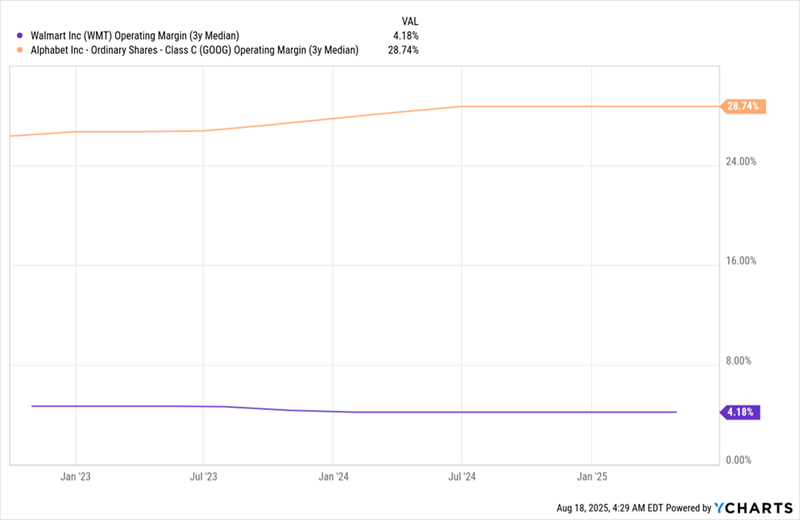
Over the last three years, Walmart Inc. (WMT), in purple above, has had a consistent 4.2% operating profit margin, while Alphabet (GOOGL) has booked a 28.7%—and climbing—operating margin. Of course, there are hundreds of firms between these extremes, but the average S&P 500 firm has an operating margin of about 13%.
Here’s another surprising stat: Profits are rising at about an 11% clip, as of the second-quarter earnings season, and most investment banks predict profit growth to continue for the rest of the year.
In short, there are plenty of companies making billions of dollars in profits out there.
But there seems to be a connection between profits and dividends: The more these firms make, the less they pay! Take Alphabet’s paltry 0.4% yield. Or Apple (AAPL), at 0.45%. Or Meta Platforms (META), at 0.3%. Amazon (AMZN)? Try 0%.
But as mentioned, there is a way to get a cut of these profits in the form of a regular income stream: lend these companies money. Better still, do so through a CEF.
Believe it or not, the largest and most profitable companies carry quite a bit of debt. Amazon has $348.4 billion worth on its balance sheet and pays regular interest on it. As long as Amazon remains financially healthy, it continues to make interest payments.
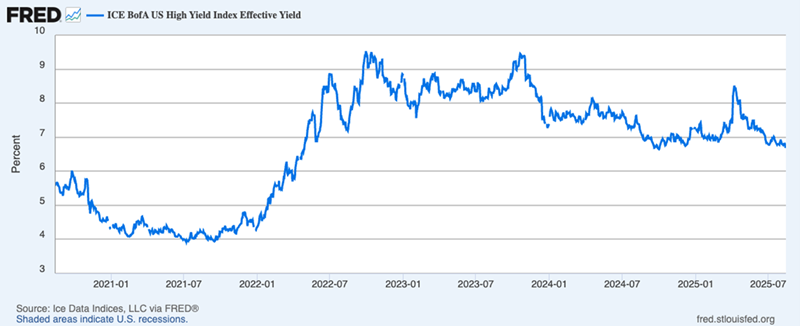
Above we see a chart of the average yield that a high-yield corporate bond pays: Currently at 6.7%, that figure was above 8% for most of 2022 and 2023.
And note this is an average, so some CEFs that hold this debt will yield more. There are other aspects of these CEFs that can alter yields, too. For instance, many CEFs buy bonds from other investors, sometimes at a discount, and a discounted bond yields more than that same bond would at par.
Before we go further, I should say that if you want exposure to these kinds of corporate bonds, there is an index fund for them. The SPDR Bloomberg High Yield Bond ETF (JNK) is a passively managed collection of these bonds, and it yields 6.6%. That’s just about what you’d expect, given the average yield of the index. And over the last three years, steady demand for these debts has driven JNK’s total return higher.
JNK’s Steady Profits
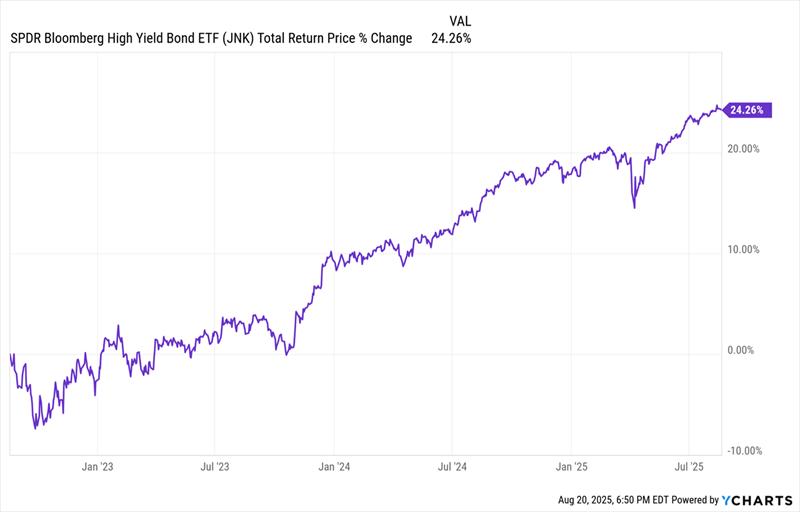
But ETFs are not our vehicle of choice here, because almost all corporate bond–focused CEFs outperform it (that’s thanks in part to their human managers, whose connections give them an edge in the cozy bond world).
Consider the 10.8%-yielding DoubleLine Income Solutions Fund (DSL), which has not only beaten JNK by a wide margin in the last decade (see orange line below), but has widened its lead considerably in the last couple of years.
DSL’s Stronger Long-Term Showing
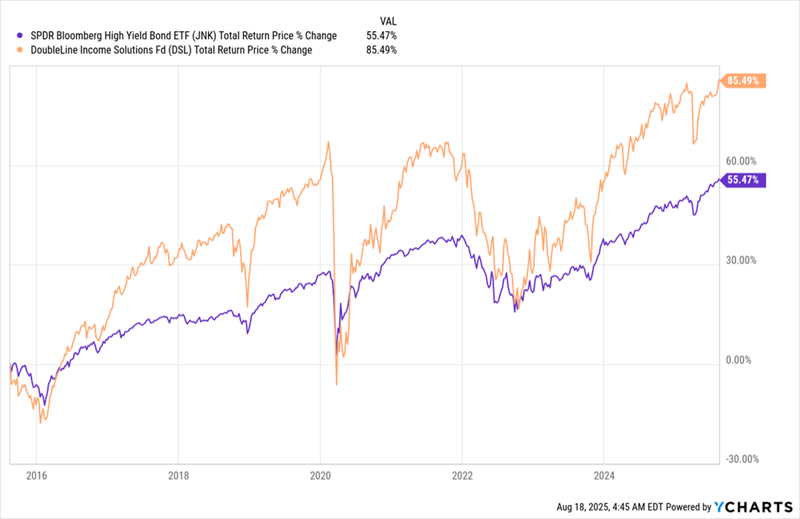
In short, DSL delivers bigger profits than JNK, and is therefore a much better option. Its high dividend also makes it a reliable choice, given that it’s paid monthly and has held steady since the dark days of the early pandemic. Management has thrown in a couple of nice special dividends, too.
DSL’s 10.8% Payout Perseveres
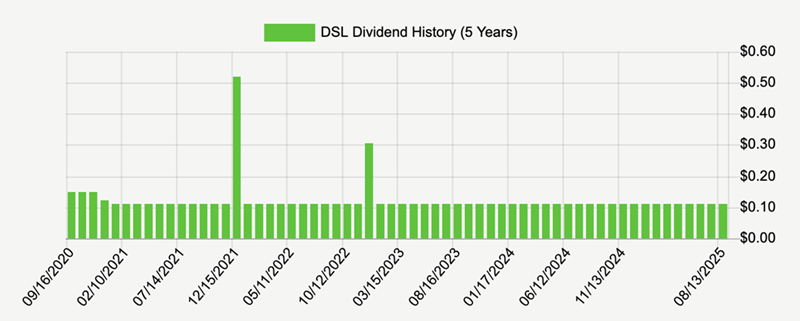
Source: Income Calendar
Still, note how it suffered steep drops in 2018 (when the market had a meltdown) and during the pandemic selloff and the inflation/recession panic of 2022? Each time, DSL’s performance fell to match that of JNK, and each was a great opportunity to buy the fund.
That will make DSL great to buy on the next dip. But what about now?
Right now, I think the Western Asset Inflation-Linked Opportunities & Income Fund (WIW) is a compelling option. It hasn’t had the same outperformance as DSL over the last decade (it’s up 59% over that period, not much above JNK’s 55.7%), but it has been putting up strong numbers—and pulling well ahead of JNK, as you can see in blue below. I expect that outperformance to continue.
WIW Manhandles Its Benchmark
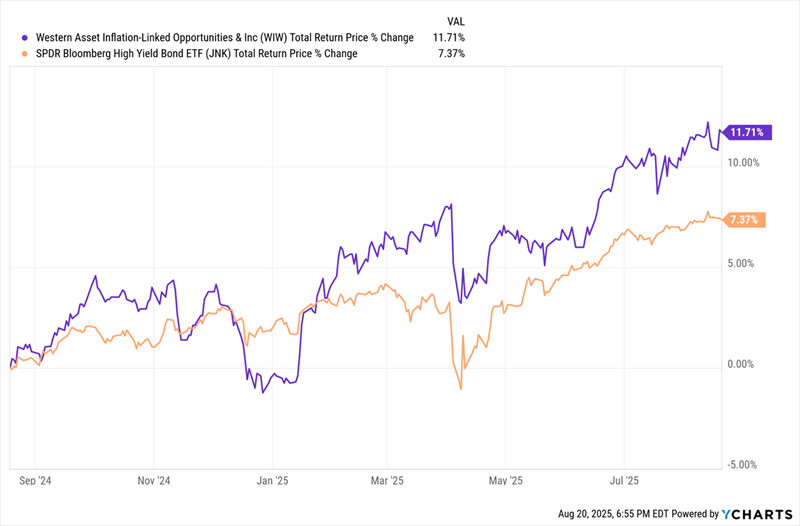
My preference for WIW comes from the fund’s name: Note how it is “inflation-linked.” That’s a fancy way of saying that the fund devotes some of its portfolio to debts that rise in value with inflation. This is noteworthy, as the vast majority of corporate bonds fall when inflation rises.
So if investors start to worry about inflation in the short term, expect WIW to gain faster than DSL and JNK. But even if that doesn’t happen in the short term, investors won’t be too upset, as the fund yields a tidy 8.5%. Not a bad amount to collect while you wait for your holdings to rise in value!
What’s more, while DSL trades around its portfolio’s market value, WIW is 9% discounted. That discount has started to fade, having been closer to 15% a year ago.
This is common for CEFs, as many trade for much less than their assets are actually worth. The fund’s high yield is also common for CEFs, which yield 8.5% on average, according to data tracked by my CEF Insider service.
That combination of discounts and high yields is what makes CEFs really special (ETFs, by contrast, never trade at a discount). They’re also why, if you’re on the hunt for passive income (and a way to grab a slice of those massive corporate profits for yourself, and in cash), I recommend giving them a closer look.
Fatter Discounts. Bigger Yields. Here’s Where to Get Them.
The two CEFs we just discussed are both strong—and smartly run. And they’re only the beginning. I’ve got 5 more funds I like even better as uncertainty starts to grip this market again. They yield a rich 9% between them and they are all unusually cheap, too.
If stocks soar, I expect these funds to clobber their benchmarks. If stocks tank, those markdowns will work in our favor, as it’s harder for a cheap fund to get cheaper! And we’ll enjoy their stout 9% dividends either way.
This is the beauty of CEF investing, and I can’t wait to show you these 5 top-flight picks. Click here and I’ll tell you more about them and give you a FREE Special Report revealing their names and tickers.
